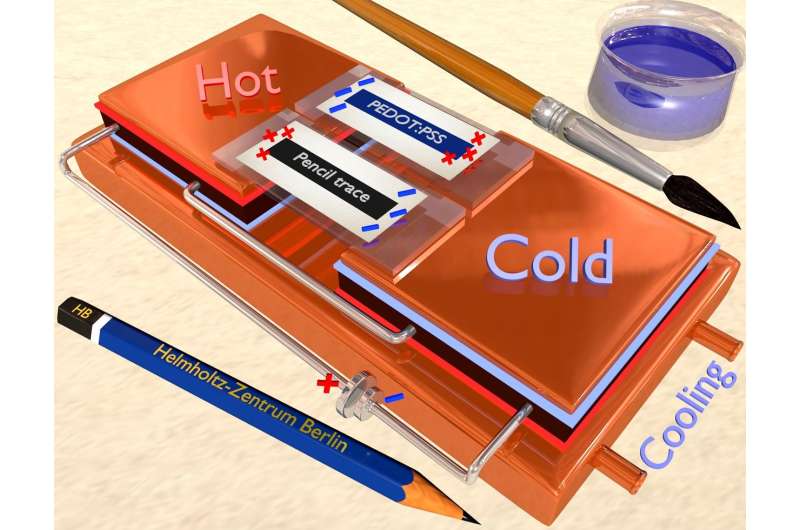Converting heat into electricity with pencil and paper

Thermoelectric materials can use thermal differences to generate electricity. Now there is an inexpensive and environmentally friendly way of producing them with the simplest tools: a pencil, photocopy paper, and conductive paint. These are sufficient to convert a temperature difference into electricity via the thermoelectric effect, which has now been demonstrated by a team at the Helmholtz-Zentrum Berlin.
The thermoelectric effect was discovered almost 200 years ago by Thomas J. Seebeck. If two metals of different temperatures are brought together, they can develop an electrical voltage. This effect allows residual heat to be converted partially into electrical energy. Residual heat is a by-product of almost all technological and natural processes, such as in power plants and household appliances, not to mention the human body. It is also one of the most under-utilised energy sources in the world.
Tiny effect
However, as useful an effect as it is, it is extremely small in ordinary metals. This is because metals not only have high electrical conductivity, but high thermal conductivity as well, so that differences in temperature disappear immediately. Thermoelectric materials need to have low thermal conductivity despite their high electrical conductivity. Thermoelectric devices made of inorganic semiconductor materials such as bismuth telluride are already being used today in certain technological applications. However, such material systems are expensive and their use only pays off in certain situations. Researchers are exploring whether flexible, nontoxic organic materials based on carbon nanostructures, for example, might also be used in the human body.
The team led by Prof. Norbert Nickel at the HZB has now shown that the effect can be obtained much more simply—using a normal HB-grade pencil, they covered a small area with pencil on ordinary photocopy paper. As a second material, they applied a transparent, conductive co-polymer paint (PEDOT: PSS) to the surface.
The pencil traces on the paper delivered a voltage comparable to other far more expensive nanocomposites that are currently used for flexible thermoelectric elements. And this voltage could be increased tenfold by adding indium selenide to the graphite from the pencil.
The researchers investigated graphite and co-polymer coating films using a scanning electron microscope and Raman scattering at HZB. "The results were very surprising for us as well," says Nickel. "But we have now found an explanation of why this works so well—the pencil deposit left on the paper forms a surface characterised by unordered graphite flakes, some graphene, and clay. While this only slightly reduces the electrical conductivity, heat is transported much less effectively."
These simple constituents might be usable in the future to print extremely inexpensive, environmentally friendly, and non-toxic thermoelectric components onto paper. Such tiny and flexible components could also be used directly on the body and could use body heat to operate small devices or sensors.
More information: Viktor V. Brus et al, Fine Art of Thermoelectricity, ACS Applied Materials & Interfaces (2018). DOI: 10.1021/acsami.7b17491
Journal information: ACS Applied Materials and Interfaces
Provided by Helmholtz Association of German Research Centres




















